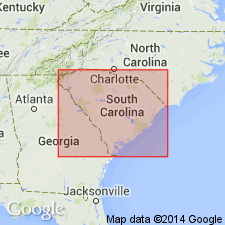
- Usage in publication:
-
- Persimmon Fork Formation*
- Modifications:
-
- Named
- Dominant lithology:
-
- Phyllite
- AAPG geologic province:
-
- Piedmont-Blue Ridge province
Summary:
Persimmon Fork Formation, here named in central SC, is composed of tan, brown, and brick red tuffaceous quartz-mica phyllite. Thickness in the area is approximately 300 m. Unit is layered, and contains many pea-sized fragments of volcanic rock. It unconformably(?) overlies Wildhore Branch Formation; underlies and grades into Richtex Formation. Age is late Precambrian or Cambrian.
Source: GNU records (USGS DDS-6; Reston GNULEX).
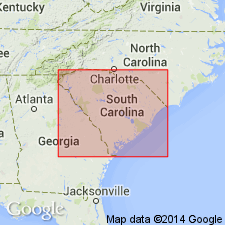
- Usage in publication:
-
- Persimmon Fork Formation
- Modifications:
-
- Overview
- Dominant lithology:
-
- Tuff
- AAPG geologic province:
-
- Piedmont-Blue Ridge province
Summary:
Unit is predominantly composed of poorly sorted intermediate to felsic crystal lapilli tuff. Layering varies from 1 to 10 m in thickness. Deposit may be an accumulation of ashflows of a volcanic debris flow. A variety of minor rock types such as vitric tuff, mudstone, wacke, ripple laminated sandstone, mafic tuff, and mafic amygdaloidal flows are interlayered with the crystal lapilli tuff. Thickness of the Persimmon Fork is estimated at 3 km. Little Mountain metatonalite is interpreted to be the intrusive equivalent of some of the felsic crystal tuff layers of the Persimmon Fork. Conformably underlies the informal Asbill Pond formation in the Batesburg, Emory, and Johnston quads. Unconformably(?) underlies or is in fault contact with the Richtex Formation elsewhere. A Cambrian(?) age is suggested by a circa 550 Ma U-Pb zircon igneous crystallization age for the Little Mountain metatonalite determined by Dallmeyer and others (1986). Persimmon Fork can be no younger than Middle Cambrian because of the fossils found in the upper part of the Asbill Pond.
Source: GNU records (USGS DDS-6; Reston GNULEX).
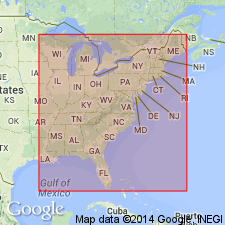
- Usage in publication:
-
- Persimmon Fork Formation*
- Modifications:
-
- Geochronologic dating
- AAPG geologic province:
-
- Piedmont-Blue Ridge province
Summary:
Rb-Sr whole rock and U-Pb zircon ages of metatuffs and meta-igneous rocks interpreted to be equivalent to Persimmon Fork Formation indicate deposition occurring between 570 and 530 Ma (Butler and Fullagar, 1978; Carpenter and others, 1982; Dallmeyer and others, 1986). Faunal assemblage in sequence above Persimmon Fork consists of Middle Cambrian trilobites of Atlantic province.
Source: GNU records (USGS DDS-6; Reston GNULEX).
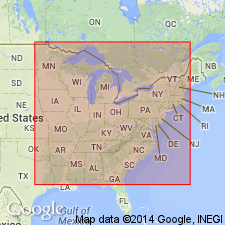
- Usage in publication:
-
- Persimmon Fork Formation*
- Modifications:
-
- Overview
- AAPG geologic province:
-
- Piedmont-Blue Ridge province
Summary:
On the correlation chart for Precambrian rocks of the conterminous United States, the Persimmon Fork Formation in the Carolina Slate Belt of the Avalonian terranes is shown to be of Early and Middle Cambrian age.
Source: GNU records (USGS DDS-6; Reston GNULEX).
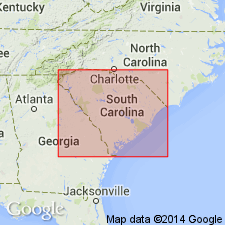
- Usage in publication:
-
- Persimmon Fork Formation*
- Modifications:
-
- Age modified
- AAPG geologic province:
-
- Piedmont-Blue Ridge province
Summary:
Age of Persimmon Fork changed to Late Proterozoic based on time scale of Brasier and others (1994; Decision on the Precambrian-Cambrian boundary stratotype: Episodes, v. 17, no. 1-2, p. 3-8) who place base of Cambrian at about 544 Ma. Persimmon Fork is thought to be coeval with metadacite of Lincolnton, dated at 566 Ma.
Source: GNU records (USGS DDS-6; Reston GNULEX).
For more information, please contact Nancy Stamm, Geologic Names Committee Secretary.
Asterisk (*) indicates published by U.S. Geological Survey authors.
"No current usage" (†) implies that a name has been abandoned or has fallen into disuse. Former usage and, if known, replacement name given in parentheses ( ).
Slash (/) indicates name conflicts with nomenclatural guidelines (CSN, 1933; ACSN, 1961, 1970; NACSN, 1983, 2005, 2021). May be explained within brackets ([ ]).

